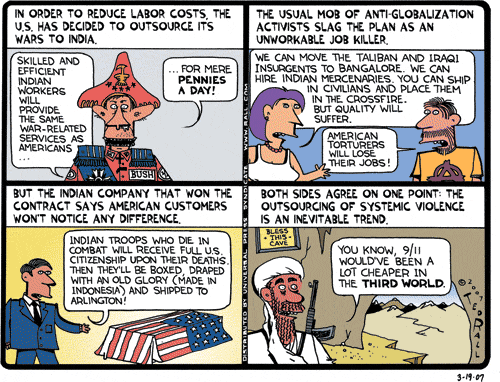
"Over 2 million children in 2,200 private schools across the country use his ‘Smartclass’ every day; 4 lakh kids so far are registered with online tutorial site WiZiQ; 4 lakh teachers have been trained just this year in skills they would have learnt if they had done a basic BEd; 14,000 computer labs have been built in government schools ...
As for whether the distance education model is flagging, Prakash points to how its share in his revenues (65 per cent at the moment) is rising — just 2,200 of the 75,000 private schools have his Smartclasses and just 14,000 of the 925,000 government schools are covered by his computer labs, an indication of how much more scope there is.
According to a CLSA brokerage report, Prakash says, Indians spend $25 billion (Rs 112,500 crore) a year on education till Class 12 and another $5.5 billion on tutoring — needless to say, he wants to be part of this great business where, to quote him, demand outstrips supply by a huge margin and the business is cash-flow negative.
Much is known about 15-year old Educomp and its success — Revenues are up from Rs 112 crore in 2006-07 to Rs 517 crore in 2008-09; Return on Investment (RoI) from 12.92 to 16.04 per cent in the same period; Return on Capital Employed (RoCE) from 28.5 to 27.8 per cent; Return on Net Worth (RoNW) from 24.1 to 35.6 per cent ... today, with 400 people just developing education content, in ten Indian languages, Prakash says, he has the largest team doing such work in the world." (via Lunch with BS: Shantanu Prakash).
After 60 years …
More than 60 years after the departure of the British, Indian media at least seems to adore ‘phoren’ educated politicians as the following news extract shows. Another journalist was effusive in praise when a DMK minister, Azhagiri took oath of office in ‘faultless’ English.
Indian-English language media today finds merit just because these Central ministers are ‘phoren’ returned. While, Indian Universities have become recruiting grounds and supply centres to the West for trained and qualified manpower, Indian media thinks that only ‘phoren’ educated and returned are good enough.
Team Manmohan crammed with A-listers
Manmohan Inc’s team would be any multinational corporation’s dream. Resume for resume, its key members are in a league of their own.
The United Progressive Alliance (UPA) council of ministers, led by the 78-year-old Cambridge-educated economist, has at least 14 ministers who have graduated from Ivy League universities like Harvard, Wharton, Stanford, MIT, Carnegie Mellon, and of course, Oxbridge. There are also Cabinet members who have degrees from US universities. (via Team Manmohan crammed with A-listers- Politics/Nation-News-The Economic Times).
English language media in India is still in its colonial haze – and to see such decadent, colonial ideas, 60 years after the British were thrown out, boggles my imagination. To approve of a politician, because he has English-language skills, or their ‘phoren’ education seems so important to these journalists, who seem to be wagging their ‘colonial’ tail with such approval – and vigor.
These journalists instead should have been worried that 60 years on, Indian Universities don't seem to be meeting standards. And looking at the (seeming) failure of these Universities.
Higher education in India
This (mixed record) of Indian Universities can largely be laid at the doorsteps of the faulty educational policies that Indian Governments have been following. For one, why is the State increasing its role in education. For another, why is the Indian State supporting English language education with thousands of crores of subsidies – while Indian language education languishes.
80% of India’s population is excluded from higher education as Indian higher system is predominantly in English. Hence, this puts a premium on English – and discounts Indian languages in the educational sweepstakes. The negative effect this on Indian self esteem is not even a point of discussion here.
The principle of exclusion (a colonial idea) is a dominant marker of the entire Indian education system – rather than inclusion. British (and before that Islamic rulers’) colonial practices supported foreign languages on the backs of the Indian taxpayers’ contribution – and actively worked on destruction of local cultures.
For instance, in the erstwhile State Of Hyderabad (equal to about 10%-12% of modern India), ruled by the Nizam, a large non-British kingdom, 2000 year old local languages like Telugu and Marathi were considered uncouth and barbaric languages – compared to a 700 year old language like Urdu, which was supported by the State. Thus anyone without the knowledge of Urdu was excluded from the system. So it is now in India, with English.
This restricts 80% of India’s population from contribution and access to opportunity. Without looking at it from an ethical point, but purely as an economic question means we should look at the cost of this policy.
English In Higher Education Institutions
The problem is actually higher education. What is the future of Marathi medium students once they reach higher education institutions? The Indian state is penalizing the Indian tax payer by granting a monopoly to English in higher education.
Cost to the Indian economy
How does this hinder India? India loses every year about 200,000 highly educated people to the West. These 200,000 people have been educated at subsidized Indian Universities at a considerable cost to the poor Indian taxpayer. What return does the tax payer get from this? Negative returns.
What happens when English stops being an important language in the global sphere? What use will India’s investment in English be at that time? And this will happen sooner than we imagine – at a greater cost than we believe.
The Indian tax payer is creating a large body of English trained graduates, who are finally picked up by Western economies at zero cost. If these Indian graduates were trained in Indian languages, the West may find it difficult to absorb them at zero cost.
English education is now clearly a liability.
What is the cost of switching from English?
Assuming that a 100,000 essential books need to translated into local languages, at a cost of say Rs.100,000 per book, it still amounts to Rs.1000 crores. Is that a large sum of money for modern India. Hardly.
What is the loss to India? How much does this reduce India’s growth rate by? Hard numbers – but definitely big numbers.
So why is India persisting with this policy. Because all the high and mighty, finally want their children to ‘escape to the West’, with a good education from India – at the cost of India’s poor. This vested interest makes this policy go around.
And a lot of propaganda.
Backdoor privatization
The Vedanta industrial group is setting up a University in Orissa. From a campus at the new Lavassa township, Oxford is going to start offering courses. These and other represent the quiet backdoor ‘privatization’ of Indian higher education.
Hidden subsidies
Large tracts of lands are being acquired by the Government, and handed over for a pittance to the private sector. Soon, we will have competition between State Sector subsidized English education – and private sector subsidized education.
Who will help Indian languages get back on their feet
While Indian language Universities are struggling – for funding, respect, status, support, foreign Universities, using paper money, backed by the Bretton Woods fraud, will impose their ideas, culture, etc in India.
While the English speaking economic bloc is struggling, India is not focussing on the French, Spanish, Japanese, Chinese Blocs which are large, excellent opportunities.
This can be a way out …
This actually is a good way out. There is a significant demand for English language education – at least currently. This demand can be met by the private sector. In the meantime, misdirected State subsidies can be gainfully used to help Indian language education get back on its feet.
In the not very long run, the state must get out of business of making up the minds of its citizens.
India starts investing in Indian languages?
On the ground, classical language status has meant substantial funds and awards. The solution to such vexed claims and counterclaims may rest in the central government giving up its partisan patronage of Sanskrit and Hindi, and providing the wherewithal for all languages. What languages are classical or not is best left to the scholars. (via Is classical language status meaningless?- Et Debate-Opinion-The Economic Times).
It has taken India 60 years to start with some small investments in Indian languages.
The Indian education system excludes a vast majority of Indians from the higher education system – which is predominantly in English. This puts a premium on English – and discounts Indian languages in the educational sweepstakes. The disadvantaged students who have studied in Indian languages ensure that their children get the ‘advantage’ of English education.
The negative effect this on Indian self esteem is not even a point of discussion here.
End of the road … the bankrupt model
This Indian education model was, till about a 150 years ago, unique in the world. With the highest literacy ratio in the world, and completely privately funded, it set global and historic benchmarks. This model has been buried under a mound of silence – and once in a while you get a glimpse of this.
My first glimpse of this model was through the draft of Parag Tope’s forthcoming book – Operation Red Lotus.
I say without fear of my figures being challenged successfully, that today India is more illiterate than it was fifty or a hundred years ago, and so is Burma, because the British administrators, when they came to India, instead of taking hold of things as they were, began to root them out. They scratched the soil and began to look at the root, and left the root like that, and the beautiful tree perished. (Gandhiji, at Royal Institute of International Affairs, London, Oct 1931 - extracted from Indian Models Of Economy Business And Management By Kanagasabapathi; Page 60).
Gandhiji, in correspondence with Sir Philip Hartog, (chairman of the Auxiliary Committee on Education), laid out the the pre-colonial scenario, which has now been buttressed by research by Dharampal, a Gandhian, in his book, Beautiful Tree, Indian Education in the 18th century.
Sreelatha Menon, seemingly, depends on Tooley’s own PR handouts to write this up. In the entire post in Business Standard, she never makes a mention of Dharampal, whose work is the most authoritative today. Tooley, a (for sometime) IFC-World Bank employee, this research resulted, (funded by the Templeton Foundation) in a book - of course called, The Beautiful Tree.
Between a rock and a hard place
Dharampal’s pioneering work, in 1983, has, not surprisingly, been ignored by the Amartya Sens and The Jean Drezes of the world – all their avid followers in India. Kapil Sibal has been trying to further the colonial British efforts by laying out a red carpet for foreign universities – while tying up Indian institutions into-knots-into-knots-into-knots. The ‘modern’ theory about Indian education goes that all credit for Indian education should go either to the British Colonial Raj or the Christian Missionary Benevolence.
The health care (USA), social welfare (USA), employment benefits (UK), showcase countries (Japan), are running countries into the ground. India has, as yet, not gone down that path. Though, the Indian State has been trying – quite hard.
 But anyway, coming to why this story get me curious, is why did Anand Jon, a haute couture designer such a harsh sentence. Unwilling /semi-willing /actively willing sex in Hollywood /Bollywood /haute couture businesses is what (I have been given to believe is) normal. I mean these days, stars /starlets 'leak' sex tapes on the internet.
But anyway, coming to why this story get me curious, is why did Anand Jon, a haute couture designer such a harsh sentence. Unwilling /semi-willing /actively willing sex in Hollywood /Bollywood /haute couture businesses is what (I have been given to believe is) normal. I mean these days, stars /starlets 'leak' sex tapes on the internet.




























